Short Article - (2025) Volume 8, Issue 1
About the Percentage Composition of the Energies of the Universe, Provided by the MAX PLANCK Institute for Radio Astronomy Exact Calculation of the Value of the HUBBLE's Constant
Received Date: Feb 18, 2025 / Accepted Date: Mar 18, 2025 / Published Date: Mar 27, 2025
Copyright: �©2025 Friedhelm M. Joge. This is an open-access article distributed under the terms of the Creative Commons Attribution License, which permits unrestricted use, distribution, and reproduction in any medium, provided the original author and source are credited.
Citation: Joge, F. M. (2025). About the Percentage Composition of the Energies of the Universe, Provided by the MAX PLANCK Institute for Radio Astronomy. Adv Theo Comp Phy, 8(1), 01-02.
Abstract
Formula (a), which is made up two formulas, show the connection between the PLANCK time and the HUBBLE's constant. When converted, it enables the exact calculation of the value of the HUBBLE's constant, which was previously obtained from astronomical measurements, and thus represents, a concrete application of formula (a).
Keywords
Energies, Universe, Calculation, Percentage Composition, Value, Constants
Introduction
Definition of Symbols Used in Formulas
EM = visible baryonic matter Ed = dark energy
H0 = HUBBLE's constant
mp = proton mass me = electon mass
á¼? = Fine structure constant of gravity
G = constant of gravitation c= speed of light
h = PLANCK's quantum of action t = time
tu = age of the universe tp = PLANCK time
The data from the MAX PLANCK Institute for Radio Astronomy is the basis. The mass / energy of the universe is composed as follows:
70 % dark energy 25 % dark matter
4-5 % visible baryonic matter
0.3 % neutrinos
Derivation of the Formula (1)
In my article “Calculation of Dark Energy and Dark Matter” [1] the formula (2.1) is derived:
E = c5 / (81/2 G H ) = 5.61 · !069 J (2.1) (1)
In my article “Equivalence of Energy and Time” [2] the formula (2) is derived:
E = (h/t 2) · t (2)
By combining formula (1) and (2) you get:
t 2 = (81/2 · hG · H ) / c5 (a)
Through change you get:
H = t 2 · c5 / (81/2 · hG) (b)
The theoretical derivation of the value for the HUBBLE's constant can be formulated as follows:
H = (G m 2 · m c) / 8 á¼ h2 (3)
Conclusion
A new formula (a) is discovered. Perhaps she can support the idea of Valentyn Nastasenko, Ukraine, in his article “Energy of the Gravitational Field as an Equivalent of the Dark Energy of the Universe” [3] is expressed. The combination of Quantum Field Theory (QFT) and General Theory of Relativity (ART) developed by ALBERT EINSTEIN could also support what Professor Alexandre Tkatchenko from the University Luxemburg says [4].
Application
The new formula (a) can be used for the exact calculation of the value of the HUBBLE's constant - see formula (b) - and thus support astronomical measurements. The formula (b) can also be compared with the value known and derived from the literure.
References
- Jöge, F. M. (2019). Calculation of Dark Energy and Dark Matter. International Journal of Physics and Astronomy, 7(1), 1-7.
- Jöge, F. M. (2022). Equivalence of Energy and Time. International Journal of Physics and Astronomy, 10(1), 1-2.
- Nastasenko, V. (2021). Energy of the Gravitational Field as an Equivalent of the Dark Energy of the Universe. Journal of Applied Mathematics and Physics, 9(7), 1541-1548.
- Tkatchenko, A. (2023). Mysterious Universe: A New Approach to Understanding Dark Energy. University of Luxembourg.



